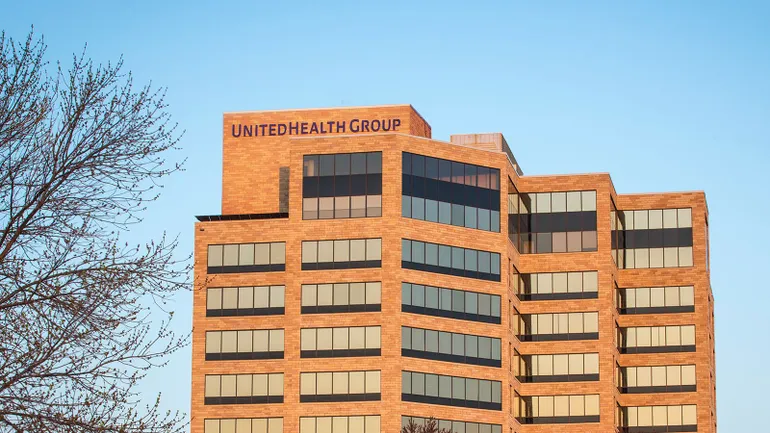Dive Brief:
UnitedHealth underperformed earnings and revenue expectations in the first quarter and lowered its earnings guidance for the full year, two signs of waning performance that analysts said were uncharacteristic of the healthcare behemoth.
The company’s first quarter problems were centered in two segments: its insurance division UnitedHealthcare, which has struggled to control heightened costs in Medicare Advantage and saw utilization spike even higher in the quarter; and its care delivery unit Optum Health, which saw patient profitability fall and was hit hard by policy changes enacted by the Biden administration.
UnitedHealth executives said both trends were addressable over the course of the year. Still, the Minnetonka, Minnesota-based healthcare giant slashed its 2025 outlook for adjusted earnings per share to between $26 and $26.50, almost 12% below the company’s original guide.
Dive Insight:
UnitedHealth’s stock plummeted 22% in Thursday morning trade following the earnings report, which CEO Andrew Witty called “frankly unusual and unacceptable” and “far from the performance we expected ourselves” in a morning call with investors.
The healthcare juggernaut’s insurance business was slammed by rising costs last year, especially in MA, and executives promised investors heading into 2025 that they had adequately priced plans to cover the trend. But in the first quarter, care activity grew at twice the rate that UnitedHealth had expected, Witty said on the call.
The increase was focused in physician and outpatient services, particularly for elective and preventative care, and was seen across individual and group MA populations, CFO John Rex said. For some members, the trend may have been driven by notably higher premiums UnitedHealth started charging this year as it tries to recoup profits.
UnitedHealth assumed care activity levels would jump for members having to pay higher premiums, but “what we’re seeing far surpasses what we would have recently anticipated,” said Tim Koel, the new CEO of UnitedHealthcare who replaced slain executive Brian Thompson earlier this year.
The development doesn’t bode well for other insurers, given UnitedHealth, which is the first publicly-traded managed care organization to report earnings, has a history of predicting trend increases prior to its peers.
The results “call into question [fiscal year] guidance for every MCO,” TD Cowen analyst Ryan Langston wrote in a note on the results.
Despite volatility in MA, UnitedHealthcare snapped up more members for the 2025 plan year and ended the first quarter with 8.2 million MA members, up 5% from the end of 2024. UnitedHealthcare’s profits also modestly improved. The insurer brought in $5.2 billion in operating earnings in the quarter, up 18% year over year.
Meanwhile, health services division Optum reported earnings of $3.9 billion, up 11% year over year but well below analyst’s expectations for the normally fast-growing business. That was mostly due to the flagging performance of Optum Health, UnitedHealth executives said.
Optum Health, which cares for more than 4 million patients in fully-capitated arrangements, added a number of new MA patients in the quarter that were previously covered by plans that exited their market for 2025. As a result, those plans didn’t adequately capture those members’ health needs, leading to lower-than-expected 2025 reimbursement levels that likely don’t reflect actual costs of care, Witty said.
In addition, many of the current and new complex patients Optum Health serves have been significantly affected by changes to MA risk modeling that the CMS is phasing in, according to the CEO.
“To be sure, it is complicated. But we’re not executing on the model transition as well as we should,” Witty said.
Witty said the company plans to address the challenges by engaging members more in home and post-discharge settings; assessing and updating the health status of new patients, especially those at high risk levels; and investing in improving physicians’ workflows to get better insights into when and where care is being delivered.
The comments suggest that UnitedHealth plans to move even more aggressively to capture diagnosis codes for its members, which translate to higher reimbursement from the government. The company has been in hot water for pressuring physicians to report as many diagnoses for its MA population as possible.
Witty also said that UnitedHealthcare’s MA plan designs — and their pricing — next year will “be fully informed” by these trends, suggesting the insurer could raise premiums further in 2026 for its Medicare members. However, the CEO said that generous payment rates finalized by the Trump administration for next year should help cover higher costs.
“We’re pleased to see the beginning of recognition of rate increases which actually reflect reality, which we haven’t seen for the last couple years,” Witty said.
Overall, UnitedHealth reported revenue of $109.6 billion in the quarter, up 10% year over year. The company reported profit of $6.3 billion, compared to a loss of $1.4 billion same time last year, when UnitedHealth was slammed with costs from a massive cyberattack on its claims processing clearinghouse Change Healthcare.


